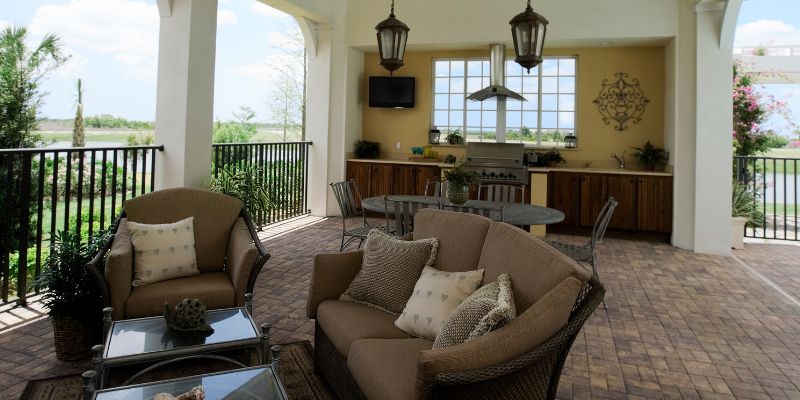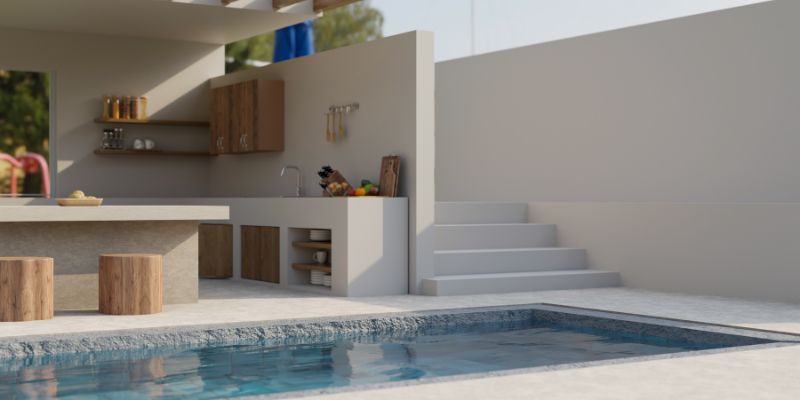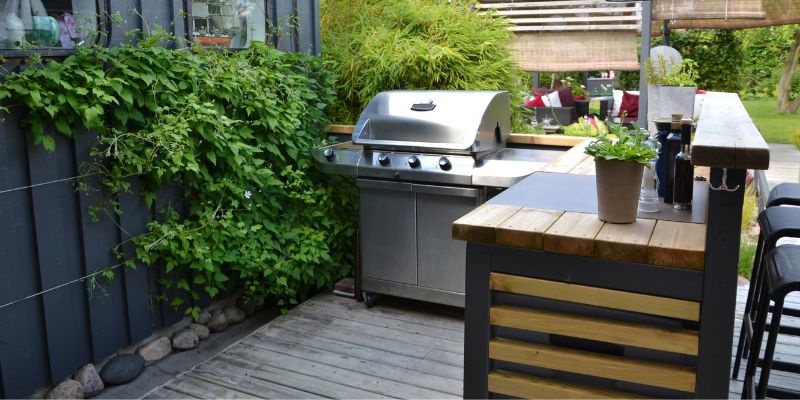Outdoor kitchens are a fantastic way to extend your living space and enjoy cooking in the fresh air. However, like any part of your home, they require regular upkeep to ensure they remain functional and attractive year-round. Whether you’re dealing with harsh winters or scorching summers, understanding how to care for your outdoor kitchen can prevent costly repairs and keep your space looking as good as new. This guide provides essential seasonal maintenance tips to help you protect your investment and enjoy your outdoor kitchen for years to come.
Table Of Contents
Preparing Your Outdoor Kitchen for Winter

Winter can be particularly harsh on outdoor kitchens, especially in regions where temperatures drop below freezing. Proper winterization is crucial to avoid damage to your kitchen’s appliances, plumbing, and surfaces.
Protecting Appliances and Furniture
As temperatures begin to fall, it’s essential to protect your outdoor kitchen appliances and furniture from the elements. Start by thoroughly cleaning all your appliances, including grills, refrigerators, and sinks. Remove any food particles and grease that can attract pests or cause corrosion over time.
Once clean, cover each appliance with waterproof and weather-resistant covers. This helps prevent rust, fading, and other damage caused by exposure to cold and moisture. If possible, store smaller appliances like blenders or portable grills indoors.
Draining and Insulating Plumbing
One of the most critical steps in winterizing your outdoor kitchen is draining and insulating your plumbing. Water left in pipes can freeze, expand, and cause pipes to burst, leading to costly repairs.
Begin by shutting off the water supply to your outdoor kitchen. Open all faucets and valves to drain any remaining water from the pipes. For added protection, use an air compressor to blow out any water that may be trapped in the lines. Finally, wrap exposed pipes with insulation to protect them from freezing temperatures.
Covering Countertops and Cabinets
Your outdoor kitchen’s countertops and cabinets are also vulnerable to winter weather. Materials like granite, stone, and stainless steel can crack or discolor if exposed to freezing temperatures and moisture.
To protect your countertops, clean them thoroughly and apply a weatherproof sealant. This creates a barrier against moisture and prevents staining or damage from ice. Similarly, clean out your cabinets, remove any food or perishables, and ensure they are dry before closing them up for the season. Consider installing weather stripping around cabinet doors to keep out moisture and pests.
Maintaining Your Outdoor Kitchen in Spring

As winter fades and temperatures begin to rise, it’s time to prepare your outdoor kitchen for spring. Spring maintenance focuses on undoing any damage caused by winter and getting your kitchen ready for use in the warmer months.
Inspecting for Winter Damage
Start by inspecting your outdoor kitchen for any signs of winter damage. Check for cracks or chips in countertops, rust on appliances, and leaks in plumbing. If you notice any issues, address them promptly to prevent further damage during the spring and summer.
Inspect your grill to ensure it is functioning correctly. Clean the burners and grates, and check for any blockages that may have formed over the winter. Outdoor kitchens often suffer from the effects of temperature fluctuations, so be sure to look for signs of wear and tear on your kitchen’s infrastructure as well.
Deep Cleaning and Restoring Shine
Spring is the perfect time to give your outdoor kitchen a deep clean. Start with your countertops and cabinets, using a mild detergent and warm water to remove any dirt, grime, or residue left over from winter. For stone countertops, use a specialized cleaner to restore their natural shine.
Next, clean your appliances inside and out. For grills, remove and clean the grates, burners, and drip pans. Wipe down refrigerators and sinks, and check for any lingering odors or stains. For stainless steel appliances, use a stainless steel cleaner to remove smudges and restore their gleam.
Replacing and Upgrading Features
Spring is also an ideal time to replace or upgrade any features of your outdoor kitchen that may have suffered during the winter. Consider upgrading your grill if it’s showing signs of wear or adding new storage solutions to keep your kitchen organized.
You might also want to consider incorporating some stylish outdoor kitchen designs that enhance the overall look of your space. Adding a new backsplash, updating your lighting, or installing a pergola can make your outdoor kitchen more functional and visually appealing.
Keeping Your Outdoor Kitchen in Top Shape During Summer

Summer is the season when your outdoor kitchen gets the most use, so it’s crucial to keep it in peak condition. Regular maintenance throughout the summer can prevent problems and ensure that your kitchen remains a focal point for outdoor gatherings.
Cleaning and Sanitizing Regularly
During the summer, your outdoor kitchen will likely see frequent use, so regular cleaning is essential. After each use, clean your grill and other appliances to prevent grease buildup and food residue. Wipe down countertops and tables to avoid attracting insects and pests.
Sanitize your sinks and countertops weekly to ensure a safe and hygienic cooking environment. For those with outdoor kitchens, it’s important to use cleaners that are safe for outdoor use and won’t damage your kitchen’s materials.
Managing Heat and Sun Exposure
While summer is the time to enjoy your outdoor kitchen Frisco, excessive heat and sun exposure can take a toll on your kitchen’s surfaces and appliances. Prolonged exposure to sunlight can cause fading, discoloration, and warping, especially for wooden cabinets and certain countertop materials.
To protect your kitchen from the sun, consider installing an awning, pergola, or outdoor umbrella. These not only provide shade but also help maintain a comfortable temperature while you cook. Additionally, move portable appliances and furniture out of direct sunlight when not in use.
Preparing for the Next Season
As summer draws to a close, it’s time to start thinking about preparing your outdoor kitchen for the fall. This means giving your kitchen a thorough cleaning, inspecting for any damage caused by summer use, and starting to plan for the next round of maintenance tasks.
Check your appliances to ensure they are still in good working order. Clean and cover them if you won’t be using them as frequently in the fall. Stylish outdoor kitchen designs often incorporate features like built-in storage, which can be useful for protecting your appliances from the elements as the seasons change.
Final Wording
Taking care of your outdoor kitchen through the changing seasons ensures that it remains a functional and inviting space for you and your family. By following these seasonal maintenance tips, you can extend the life of your outdoor kitchens and continue to enjoy cooking and entertaining in the fresh air, no matter the time of year. Whether you’re preparing for winter, refreshing for spring, or keeping things in check during summer, a little maintenance goes a long way in preserving the beauty and functionality of your outdoor kitchen.
FAQ’s
1. How often should I clean my outdoor kitchen appliances?
It’s best to clean your outdoor kitchen appliances after each use to prevent grease buildup and food residue, which can attract pests and lead to corrosion. For a deeper clean, aim to sanitize your appliances and surfaces weekly, especially during peak use in the summer months.
2. What should I do to prepare my outdoor kitchen for winter?
To prepare your outdoor kitchen for winter, start by thoroughly cleaning all appliances and surfaces. Drain and insulate your plumbing to prevent freezing, cover your appliances with weatherproof covers, and apply a weatherproof sealant to countertops to protect them from moisture and freezing temperatures.
3. Can I use my outdoor kitchen year-round?
Yes, you can use your outdoor kitchen year-round, but it requires proper maintenance and preparation for each season. In colder months, you might need to invest in patio heaters or an outdoor fireplace to keep the space comfortable. Regular maintenance will ensure that your kitchen remains functional no matter the season.
4. What are some signs that my outdoor kitchen needs maintenance?
Common signs that your outdoor kitchen needs maintenance include rust on appliances, cracks or chips in countertops, leaks in plumbing, and faded or discolored surfaces. Regular inspections, especially after harsh weather conditions, can help identify and address these issues early.
5. How can I protect my outdoor kitchen from sun damage?
To protect your outdoor kitchen from sun damage, consider installing a pergola, awning, or outdoor umbrella to provide shade. You can also use UV-resistant covers on your appliances and furniture when not in use. Moving portable items out of direct sunlight and applying UV-protective sealants to countertops can also help prevent fading and discoloration.







